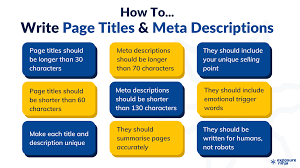Your title tag is like the first impression of your webpage in search results. It’s what grabs attention, boosts click-through rates (CTR), and helps search engines understand your content. So, how do you craft the perfect title tag? Let’s break it down in a simple, engaging, and SEO-friendly way! 😃
Why Are Title Tags Important?
Title tags appear:
- In search engine results as the clickable headline.
- On browser tabs, helping users navigate multiple pages.
- On social media shares, influencing engagement.
A well-optimized title tag increases visibility, rankings, and organic traffic. But a poorly written one? It can get ignored by both users and search engines. 😬

How to Write the Perfect Title Tag
Follow these best practices to make your title tags work for you, not against you:
✅ Keep It Under 60 Characters – Google cuts off longer titles in search results. ✅ Include Your Primary Keyword Early – Helps search engines and users understand the topic immediately. ✅ Make It Engaging – Write for humans first, then optimize for search engines. ✅ Avoid Keyword Stuffing – “Best Social Media SEO Digital Marketing Agency” ❌ ✅ Use Power Words – Words like “Best,” “Ultimate,” “Guide,” and “Proven” increase engagement. ✅ Match Search Intent – Understand what your audience wants to see. ✅ Brand It When Necessary – Adding your brand name at the end can boost recognition (e.g., “SEO Best Practices | Social Media Max”).
Title Tag Examples That Work
Bad Example: 🔴 “SEO, Digital Marketing, Social Media, Google Ads, Facebook Ads” 👉 Too broad, stuffed with keywords, and lacks a clear message.
Good Example: 🟢 “SEO Best Practices to Rank Higher in Google | Social Media Max” 👉 Concise, keyword-rich, and engaging!
The SEO Impact of Optimized Title Tags
A well-written title tag can: 📈 Improve search rankings ✅ 👀 Increase CTR (Click-Through Rate) ✅ 🔍 Help Google understand your content ✅
Optimize Your SEO Strategy with Social Media Max
Need expert SEO help to optimize your title tags and boost rankings? At Social Media Max, we create high-performing SEO strategies for businesses like yours! Contact us today at 0161 399 3517 or email Syed_66@hotmail.com to get started!
